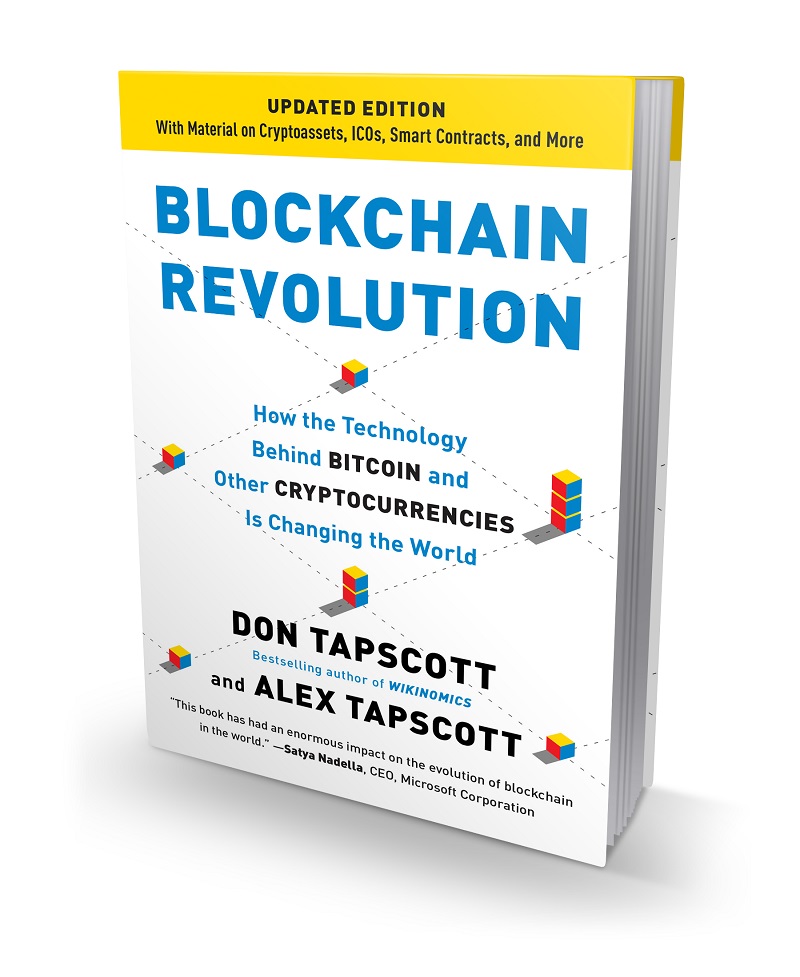Punditry runs in this family. Don Tapscott has been writing about business strategy for decades, doing everything from pontificating about Wikinomics to giving Ted Talks about the future of money. And now his son, Alex Tapscott, has joined the family business as a speaker, investor, writer, and adviser on emerging technologies. The younger Tapscott’s own Tedx Talk on blockchain has been viewed more than 630,000 times.
The Tapscotts are excited about the revolutionary potential of blockchain. It’s a 2018 phenomenon, but they are certainly not late to the party. In 2016, they coauthored The Blockchain Revolution: How the Technology Behind Bitcoin Is Changing Money, Business, and the World. The book has been a bestseller in a few countries and has been translated into 18 languages. Now it has been updated in its paperback edition, which hit the streets in June. It’s all about how decentralized cryptocurrencies, bolstered by the security and transparency of blockchain, could disrupt all sorts of traditional businesses, including banks.
“The success of the book internationally reflects the global nature of this whole industry. This is not something where all the value and innovation is being created in Silicon Valley. It’s not like the early ’90s. The technology is global, and the phenomenon is global as well,” said Alex Tapscott, in an interview with VentureBeat.
In 2017, Alex Tapscott and his father cofounded the Blockchain Research Institute, a multi-million-dollar think tank that is investigating blockchain strategies, opportunities, and use cases. I talked with Alex Tapscott about what has changed in the past few years and where blockchain is heading.
June 5th: The AI Audit in NYC
Join us next week in NYC to engage with top executive leaders, delving into strategies for auditing AI models to ensure fairness, optimal performance, and ethical compliance across diverse organizations. Secure your attendance for this exclusive invite-only event.
Here’s an edited transcript of our interview.

Above: The Blockchain Revolution by Don Tapscott and Alex Tapscott.
VentureBeat: You’ve been paying attention blockchain for a while. The book came out in 2016, right?
Alex Tapscott: Yeah, the first edition of the book was May 2016.
VentureBeat: You updated it for the paperback here?
Tapscott: When the book came out, the world was much different than it is today. We felt there was a need to update on what had happened in the last couple of years. But I will say the book ended up holding up really well, when we went back and reviewed all the core ideas we wrote about.
VentureBeat: It seems like it was good to be in on this early, or at least early in the first round of the craze.
Tapscott: It was certainly good timing. It’s better to be lucky than smart, they say. When the book came out, it was right around the time that this was transitioning from a small and passionate community of users and technologists was interested in to something that the world at large was becoming interested in. People began to appreciate the implications for the technology, beyond Bitcoin and cryptocurrency, although that’s still an enormous part of the space.
VentureBeat: How would you summarize what’s changed from 2016 to 2018?
Tapscott: A lot has changed, but the one thing that’s really changed is the proliferation in the asset class itself. When the book came out, the value of all crypto assets combined was around $10 billion. Put another way, that would be the smallest constituent of the S&P 500 index. Fast forward to today, [when] despite the volatility we’ve seen, the value of the market is more than $250 billion, which is bigger than most large companies, though obviously still small compared to other asset classes.
The big thing that’s caught a lot of attention in the past couple of years is the growth in so-called ICOs, token fundraising. We’ve seen the value of these raises increase pretty significantly. In 2015 the value was in the $5-10 million range. In 2016 it was around $165 million, and most of it was one particular financing called the DAO. But if you look at last year, it was around $5 billion, and this year to date it’s around $10 billion.
It’s begun to have a profound impact on the world of venture capital in terms of how entrepreneurs access funds to grow and start a business, but also, it’s changed the nature of how companies organize. These new entities look a lot more like networks than they do traditional companies and traditional organizations.
What we did for the book, to help summarize this, was to create a taxonomy for crypto assets. What are all these things? Why do they matter? Why are they valuable? Where is the whole space going? Or at least our best answers to that. We ended up defining or identifying seven different types of crypto assets, which we talk about in the book.
The seven types are, one, cryptocurrencies like Bitcoin; two, protocol tokens, like Ethereum; three, app coins or utility tokens, tokens specific to applications that could be doing any number of things; four, so-called security tokens, digital versions of financial assets; five, natural asset tokens, digital assets that have a connection to an asset in the real world, like a barrel of oil; six, cryptocollectibles, unique digital assets; and finally, seven, crypto-fiat currencies, digital assets being created by governments.
VentureBeat: At this point do we have a handle on where the bulk of the startups are, the companies in this space?
Tapscott: Most of the startups that have done these things in the past year and a half have launched what’s called a utility token. Most of those utility tokens have been launched on one platform, Ethereum. Ethereum, I think a lot of people confuse it with Bitcoin, as another currency. It isn’t really a currency. The token is a way for paying for usage of the network. All of these applications are built on the Ethereum network, and the more applications that are built, the more funds get raised, the more demand there is for the underlying token, Ether. But each of these individual apps also have their own token.
If you look at the number of projects that have raised money over the last year and a half, it’s been at the utility token level. If you look at where most of the value has been captured, the vast majority is still in categories one and two. To this day, more than 40 percent, almost half the value of all crypto, is still Bitcoin.
My perspective personally is that Bitcoin currencies are a great use case for digital assets. It’s a way to move and store value peer to peer. It can act like gold, as a store of value that’s fungible, meaning you can spend it and send it. It’s a way to pay for goods and services. All of those things give it utility and make it super valuable. I think Bitcoin is going to continue to grow and become more important.
But in turn, a lot of value is going to be captured in that second category. We’re already seeing that with projects like Ethereum, where Ethereum can be more than just one thing. It’s general purpose. It can run lots of applications. We’ve seen games and casino applications and betting networks and marketplaces and shared economy companies. All sorts of different business models that try to connect buyers and sellers, different individuals, in a way that’s peer-to-peer without central intermediaries. There are lots of use cases for that.
A lot of the value will continue to migrate long term away from cryptocurrencies and into these protocol currencies. Eventually the apps will become valuable. But if you look at today, most of the apps are not commercial, meaning they haven’t really launched. A lot of that has to do with some specific bottlenecks at the protocol level. Until the protocols themselves are super fast and powerful, the apps will be limited.
A good analogy would be, say, somebody launched a video streaming application in 1993. It’s a great idea. Netflix ultimately came to dominate that. But at the time, the underlying technology could barely process language and imagery, let alone high-definition video. A lot of these concepts are ideas whose time, basically, has not come yet. Eventually as the technology scales and becomes better, the apps will become more valuable.
VentureBeat: A lot of the concern in the space has been around fraud related to some ICOs. I remember the Wall Street Journal earlier this year, they looked at 1,450 ICOs and found fraud problems with nearly 300 of them. How do people come to terms with that challenge?
Tapscott: Fraud in the space is a big problem. It’s important to differentiate between two things. There are projects that don’t succeed, because the idea is flawed or the execution is flawed or any number of reasons. And then there are projects that are outright fraud. Lots of startups fail. Just because they fail doesn’t mean they weren’t well-intentioned. Many of the projects we’ve seen fall into that category. But a certain number fall into the fraud category.
The reason that these have been allowed to proliferate — or not allowed to, but have been able to – is because the market itself is still very new. There isn’t a lot of self-regulation or oversight. Most of the participants are what would traditionally be called retail. They’re individuals, not institutions. Regulators are not particularly — at least historically, they have not had an active hand in this marketplace.
My perspective is that this is, in many ways, a new asset class, a new asset category, and there’s lots of opportunities for innovation. But that doesn’t mean that, just because it’s a new and innovative area, there shouldn’t be sensible oversight and regulation. There are lots of existing laws that deal with things like market manipulation or Ponzi schemes and so on. Those rules should be applied vigorously to this marketplace in order to cut down on that fraud. When that happens, the marketplace will be much more vibrant and will be able to sustain more growth in the long term.
In terms of innovation and regulation writ large, that’s a more complicated question. Criminal activity, it’s easy to say that we want to stop that and it should be stopped. But there are lots of ways in which this technology transcends or conflicts with the current rules. Specifically, are these different token offerings securities offerings, or are they something else? I think many of them would fit the bill of a securities offering, but some might not. Being able to differentiate between those is a central challenge.
To their credit, a lot of regulators at the SEC have done a terrific job of working to understand this, talking to people in the industry. They’ve been vigorous when they see wrongdoing, and that’s fine. They’ve been open-minded when the questions are more complex. But figuring out the answers to this is going to be a tough one, and I think it will require a multi-stakeholder approach, where industry, regulators, and other stakeholders have a voice and are able to articulate their opinions.
VentureBeat: As far as the generation of technology, I’m coming across more pitches from startups that are going to make blockchain both secure and fast. There seemed to be this tradeoff early on. The Hedera Hashgraph people recently raised a lot of money on their blockchain alternative idea, to make a network that could operate with millions of transactions per second. Does this seem like a big problem for everyone to tackle?
Tapscott: Scalability is one of the most critical challenges. It’s a bottleneck. There’s a cool use case — are you familiar with CryptoKitties? It’s an interesting application of a technology. I think crypto collectibles is going to be a huge area. But in the early days, it bogged the Ethereum network down with its transaction volumes. We’ve seen that before with large ICO activity. It’s an example of how the network is amazingly powerful in some ways, but in other ways, if it can’t handle one application, how are we going to put something like the NASDAQ on the Ethereum network? It’s not feasible today.
Hashgraph is one of many — what do they call themselves? Third-generation blockchain protocols? They’re trying to do what Ethereum does in the sense that it’s a general-purpose platform. You can use it for a lot of applications. It’s customizable. You can use it for permissioned and permissionless use cases. However, it’s also secure and scalable.



